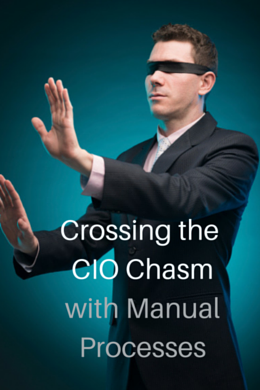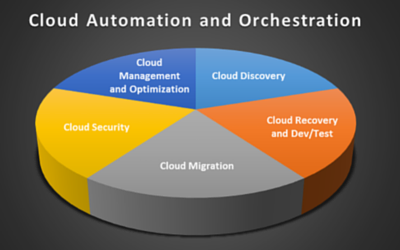CIOs Must Cross New Chasm Of Disruption
Since January I've published a pair of articles on what I consider to be early signs of a massive transformation of enterprise IT. Who will be crushed by Digitalization and the Cloud and Two Recent M&A Moves both addressed the new CIO chasm of digitalization and cloud.
what I consider to be early signs of a massive transformation of enterprise IT. Who will be crushed by Digitalization and the Cloud and Two Recent M&A Moves both addressed the new CIO chasm of digitalization and cloud.
Enterprise infrastructure (IGN) is growing to levels of scale, complexity, cost and availability pressures well beyond the wildest dreams of any enterprise infrastructure hardware vendor.
Employees, partners, customers, etc. are accessing that infrastructure through endpoints that have as much software/functionality loaded into them as the early software stores. This represents an unprecedented level of scale, complexity and criticality, even for the largest of IT shops.
Digitalization with Cloud: The New CIO Chasm
The Internet of Things as it's called is becoming a misnomer. It's really an Internet of Applications.
That may seem like a trivial distinction, but it makes all the difference in how one frames the disruption that has already destroyed the growth projections of most hardware vendors. You've seen the forecasts for infrastructure growth. Mark Thiele, for example, recently predicted that the world will need 400 million servers by 2020. There is also an explosion in endpoints as the Internet of Things (IOT) redefines the meaning of "end-user" in the age of machine-to-machine communications. Thiele cited predictions ranging from 20 billion (Gartner) to 50 billion (Cisco) endpoints in the near future.
The real explosion is inside the growing population of endpoints and the servers.
 A recent survey found that the average Android user has 95 apps installed on their smartphone, supporting about 100 daily interactions via an average of 35 apps. Yet the explosion in apps has not translated into enhanced growth and margins for many of the hardware vendors. Software is continuing to drive hardware.
A recent survey found that the average Android user has 95 apps installed on their smartphone, supporting about 100 daily interactions via an average of 35 apps. Yet the explosion in apps has not translated into enhanced growth and margins for many of the hardware vendors. Software is continuing to drive hardware.
The growth in software that enables enhanced usability, agility, scalability, availability, manageability and security. Commoditization of the "things" is already underway, as software and apps become as strategic to endpoints as they became to PCs.
We've Seen This Before
The branch office boom and the enterprise web had a similar dynamic. They created pressures for more application layer (referencing the OSI layers, especially 4-7) innovation to support increasingly diverse, specialized networking challenges. Companies like F5 and Riverbed focused on addressing these demands and companies like Cisco, Juniper and Citrix augmented their capabilities with the acquisitions of FineGround, Redline Networks/Peribit and NetScaler, respectively. The server load balancing market cratered as the demands shifted toward traffic management first, and then evolved toward secure application delivery.
Application delivery challenges today are more complex and exponentially more critical than they were ten years ago, when digitalization and smartphones were in their infancy (in terms of numbers shipped and, more importantly, installed applications). Today, there are more apps in a single smartphone interacting 24/7 with an enterprise server and other apps than there were interacting from a branch office to HQ during business hours a decade ago.
The apps trigger the orders and the queries. They determine who is ordering what from whom. They update key supply chain and analytics.
Outages, therefore, are becoming strategic issues even for second and third tier apps, as they are getting interconnected with other mission critical apps.
Don't Forget the Cloud
In terms of app and service delivery the cloud becomes more than a necessity; it becomes an eventuality. Enterprises cannot cost effectively manage the 24/7 demands, including scale and complexity of this new world of digitalization. Even Salesforce, perhaps one of the most advanced and well-managed SaaS offerings has capitulated and switched from their own cloud to a public IaaS cloud.
The cloud will drive an even larger app delivery disruption than the branch office and enterprise web boom because the stakes are even higher and the complexities greater. Instead of another appliance (a cloud front end - lol) it will be software: cloud automation and orchestration software. This emerging category will include cloud management and optimization, cloud recovery and Dev/Test, cloud migration, cloud security and cloud discoverysolutions. These technologies will drive IT into new levels of resilience and productivity as these new digitalization and cloud chasm demands emerge.
technologies will drive IT into new levels of resilience and productivity as these new digitalization and cloud chasm demands emerge.
We may likely see the emergence of innovative cloud "brokerages" that will help CIOs address these exploding complexities. New approaches will be needed in much the same way as exploding volume and complexity forced the financial services industries to evolve from 1990's era infrastructures, applications, policies, and governance structures. Comparing Wall Street's transaction volumes of two decades ago against what it does today, you can see that digitalization and cloud will have an even greater impact on a broader range of corporate operating models.
Enterprises are still trying to tackle these changes with yesterday's tools. For example, they continue to throw scripts and manual processes at the problems they are facing. The challenges will mushroom as enterprises try to fulfill CIO directives without automation. See The Trillion Dollar Cloud Question. And that is just the beginning.
Digitalization and Cloud for enterprise CIOs will be the equivalent of globalization on steroids: robust, real-time app queries across a growing range of endpoints into an exploding mesh of cloud workloads. In this very disruptive scenario resilience becomes strategic to growth, margins and the CIO chasm.
The Resilient Enterprise
Gartner in 2015 determined that 80% of outages are caused by either operation errors or app failures. The remaining 20% included hardware, OS, security, power and disaster events. Put that within the context of this greater mesh of the Internet of Applications (robust endpoints with dozens of apps interacting more frequently, including micro-transactions).
CIOs will have to arbitrate the growing conflict between static, manually scripted actions needed to address increasingly dynamic demands within ever complex app environments in hybrid clouds. Software is the best answer.
It's no wonder that Gartner is already tracking business resilience and increased spending, especially on second and third tier apps. The first critical mission for the cloud for existing apps, therefore, may be to automate manual processes related to resilience, as IT today already cannot keep up with accelerating demands. See, for example, DR is Broken, Just Don't Blame IT.
This also extends to security. Enterprise security teams must shift from further futile investments in legacy prevention technologies to more real-time, software-centric automated behavioral analytics and incident response technologies for greater resilience to recover from attacks they cannot stop.
Transformation will involve: 1) app modernization; 2) hybrid IT - using cloud IaaS as needed (see this very useful blog on evaluating apps for cloud migration); and 3) software-driven automation.
It is natural for traditional IT to think initially of scripts and manual processes to tackle the problem. Yet as delays and issues manifest themselves automation will become a necessity. The alternative is CIO blindness during perhaps the greatest transformation in IT since the advent of the network. Investing in key capabilities will also help CIOs take their seat at the strategy table by finally aligning with and enabling the business rather than being a mere cost center.
Disclosure: more



